#oncorhynchus nerka
Explore tagged Tumblr posts
Text

you have to keep going no matter what
548 notes
·
View notes
Text
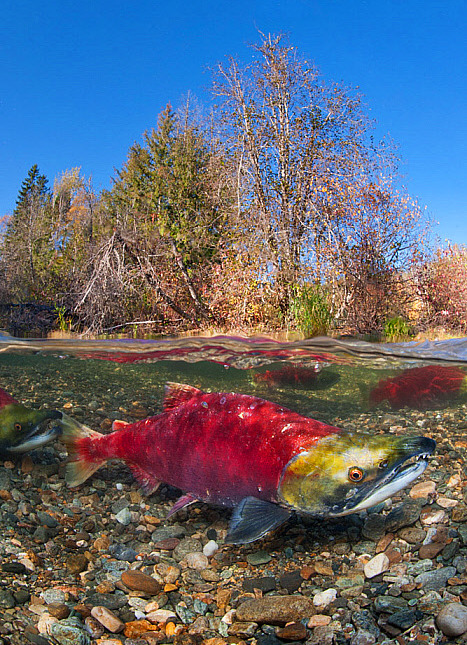

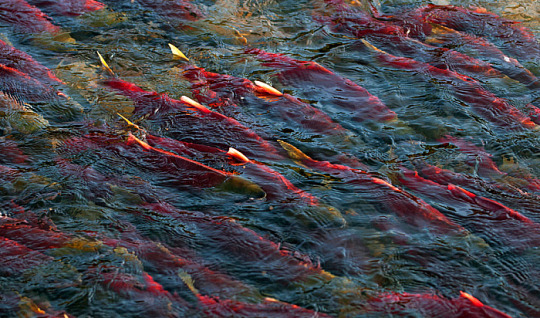
Male sockeye salmon (Oncorhynchus nerka) in Adams River, British Columbia
Photos by Alex Mustard
#Oncorhynchus nerka#Oncorhynchus#salmon#sockeye salmon#red#fish#red fish#male salmon#salmon river#adams river#river#river fish#british columbia#animals#wildlife#nature#breeding season
5K notes
·
View notes
Text

Each year between July and September, millions of sockeye salmon migrate from the Pacific back up rivers to the fresh waters of Lake Kuril, to spawn in the waters where they were born. This volcanic crater lake, in the South Kamchatka Sanctuary in the Russian Far East, is the largest sockeye salmon spawning ground in Eurasia. The annual glut attracts Kamchatka brown bears from the surrounding forests to feast on the fish and fatten up for hibernation. Following the example of the bears, Valter waded into the icy water to get the right perspective and to wait for an action moment - a real test of physical endurance. By doing so, 'I almost became one of them,' and 'in the silence of the Garden of Eden I did not think about anything else.' This bear reared up some three metres on its hind legs and scanned the water for fish. Suddenly it pounced on a female salmon swollen with roe, the force sending a string of crimson eggs spinning out of her body.
Brown Bear & Sockeye Salmon | Valter Bernardeschi
#dispatch#salmonidae#ursidae#salmoninae#ursinae#oncorhynchus#ursus#oncorhynchus nerka#ursus arctos#brown bear#sockeye salmon#valter bernardeschi
21 notes
·
View notes
Text

Sockeye salmon / Oncorhynchus nerka, gouache painting
#ft the spiral bound holes because i liked how they looked so i kept them#salmon#sockeye salmon#oncorhynchus nerka#gouache#gouache painting#I was gonna scan this but i got tired of putting it off LMAO#still gotta scan some others grrr#also i need to paint more fish#this is my second finished gouache painting ever. be nice#myart#art to shit your pants to#traditional art
23 notes
·
View notes
Text
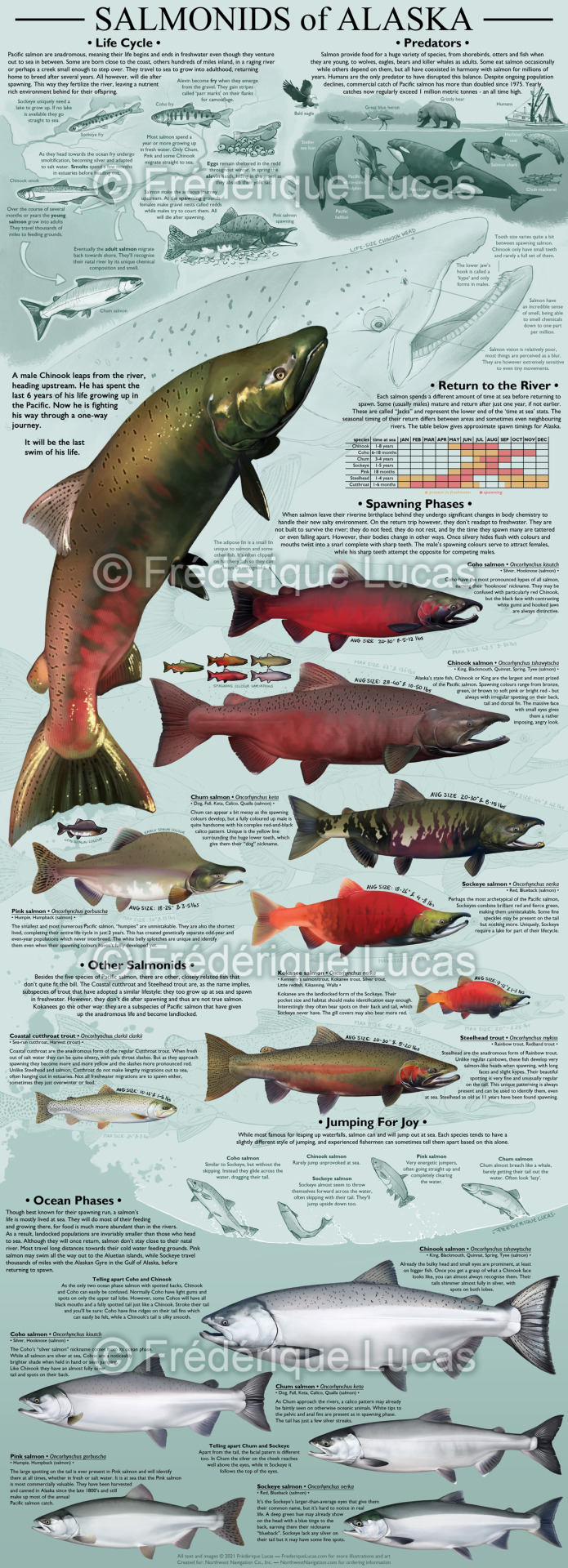
SALMONIDS of ALASKA The bane of my existence for the entirety of 2020 and part of 2021: the salmon poster. You've seen the separate illustrations, but now, finally, here is the full thing.
This entire project was a journey. I had never illustrated fish before, let alone in this much detail. I have retained an appropriate hatred of scales and fin rays from this project. But also a persistent joy from having created these illustrations, and appreciation for what beautiful animals these salmon are. Putting together the poster, making all elements fit together and - not unimportantly - making the poster fit its allotted space on the wall was an additional endeavour.
It is currently displayed aboard the David B, the vessel of Northwest Navigation who commissioned this piece. If you're interested in having a copy of your own, you can contact them. For now I hope you enjoy reading this (if you open the image in a separate tab, I made it big enough to read) - and mayhaps learn something new about the intriguing world of salmon! I certainly did.
#poster#illustrations#scientific illustration#Salmonids of Alaska#Salmonid#Alaska#Chinook salmon#Oncorhynchus tshawytscha#Coho salmon#Oncorhynchus kisutch#Chum salmon#Oncorhynchus keta#Pink salmon#Oncorhynchus gorbuscha#Sockeye salmon#Oncorhynchus nerka#Steelhead#Oncorhynchus mykiss#Coastal cutthroat#Cutthroat trout#Oncorhynchus clarkii#salmon#trout#digital art
138 notes
·
View notes
Text

#I’ve more fish!#traditional art#sketch#my art#coloured pencils#sockeye salmon#oncorhynchus#oncorhynchus nerka
30 notes
·
View notes
Text

some salmon graphic design studies.
sockeyes are weird. they are so weird. gotta capture that weirdness
19 notes
·
View notes
Text
Relatable
49 notes
·
View notes
Text

MerMay's 30th mermaid was a Sockeye Salmon!
#art#mermaid#mermay 2023#mermay#fish#sockeye salmon#salmon#oncorhynchus nerka#colour#pencil#traditional art#daily#artists on tumblr#valerianart
1 note
·
View note
Text
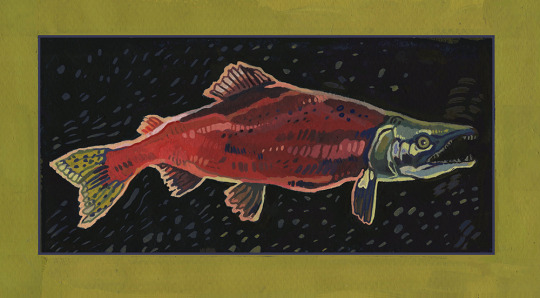
sockeye salmon
And the final guy in the new gouache fish gang is here! I mean I painted him months ago, but then, as always, I forgot to post him :'D The in(famous) horny fish!
#salmon#sockeye salmon#fish#gouache#illustration#art#There's this one dumb thing about these guys that's been bothering me all my life#besides their unusual transformation - their latin name is “Oncorhynchus nerka”#so they're called just “nerka fish” in Polish. Thing is#nerka means kidney in Polish and I always thought that t's named after it... funnily enough thar part of the name is of Russian origin and#basically#tied to the breeding season transformation of these guys) :' D that was a really random thing to mention but fr I had no idea why they're n
2K notes
·
View notes
Text

Here's a big project I've been working on for a few weeks: a phylogenetic tree of everything in Minecraft! It would take ages to explain everything here, so if you want an explaination of any inclusions, exclusions, categorisations or Latin names PLEASE PLEASE PUHLEASE ask me I would love to answer any questions :3
Here's the slides I used to make it since i'm aware the text on the image there is pretty much unreadable.
Reblogs appreciated!
Edit: there are some problems with the image on here aside from the quality, so please check the slides for a slightly more accurate version! Also, if you have a question check the notes first! Odds are someone else has asked already.
Edit 2: PLEASE check the reblogs before you ask a question, most of the questions I'm getting now are ones that have already been answered. But I of course really appreciate how much people care :3
Full image description:
At the bottom is the Origin of Life, which branches out into five kingdoms - amoebozoa, animalia, fungi, algae and plantae.
Amoebozoa is in pink. It branches into Sculk (latin name sculk sculk) and then into slimes (scindo uliginosus) and magma cubes (scindo igneum)
Animalia starts off in orange. It branches off into the five types of coral (Fire - millepora, horn - rugosa, tube - tubipora musica, bubble - Plerogyra sinuosa, brain - diploria). The second branch of animalia branches off to the sponge (in the phylum demospongiae) and then to molluscs and arthropods.
Moluscs first branches off to the shulker (duopartes purpur) then to the nautilus (latin name nautilus), the ghast (Exspiravita inferno) the heart of the sea (unknown latin name), the squid (Immiforma caeruleum) and the glow squid (Immiforma crepuscula). The heart of the sea and nautilus are both marked with a dagger symbol, indicating they are extinct.
Arthropods branches off to the enderman (gracillis sapiens) and the ender dragon (draconiforma finis). It also branches off into insects, featuring bees (bombus enormus) and silverfish (Lepisma saccharinum), as well as to arachnids, featuring the endermite (terminus limina), the spider (rufoculos nocturnis) and the cave spider (rufoculos caverna).
Carrying on from the branch of animalia is the sea pickle (Pyrosoma) and then the vertebrates, which are coloured in reddish orange. The first branch contains the Queen angelfish (Holacanthus ciliaris), the emperor red snapper (Lutjanus sebae) and the moorish idol (Zanclus cornutus). the second branch contains salmon (Oncorhynchus nerka). The third branch contains the yellowtail parrotfish (Sparisoma rubripinne), the clownfish (Amphiprion percula) and the dottyback (Diadem pseudochromis). The next branch contains cod (Gadus). the final fish branch contains the triggerfish (Abalistes stellatus), the pufferfish (Arothron meleagris) and the yellow tang (Zebrasoma flavescens).
Next the branch transitions into tetrapods. coming off this are amphibians, which includes the frog (Lithobates thermochroma) and the axolotl (Ambystoma mexicanum)
image desc currently unfinished, would appreciate help
10K notes
·
View notes
Text
Happy 2025 everyone

You all get a Sockeye Salmon
Oncorhynchus nerka
726 notes
·
View notes
Text
Fish of the Day
Today's fish of the day is a bit different from normal, instead of focusing on a particular species of genus we will be focusing on landlocked salmon today by special request of Topi!

(Atlantic Salmon)
Landlocked salmon are notable due to the inherent nature of the salmon life cycle, where salmon hatch in a freshwater stream, migrate to the ocean until they achieve sexual maturity, and then travel back to the same stream they hatched from. However, landlocked salmon are unable to migrate and spend their life cycles entirely in freshwater. The three main landlocked salmon would be The Kokanee salmon (Oncorhynchus nerka), which are a subspecies of sockeye salmon, the Formosan landlocked salmon (Oncorhynchus masou formosanus), which is a subspecies of masu salmon, and finally the several populations of landlocked Atlantic salmon (Salmo salar).

(Formosan landlocked salmon)
Landlocked salmon hold almost no differences to their sea run relatives, other than that which speciation provides. Almost always landlocked salmon are far smaller. Considering that salmon are mid level carnivores, whose diet shifts based on age, freshwater prey is just simply less available than marine prey is. Salmon fry survive off of zooplankton, which is available in large amounts in freshwater, but as they grow into juveniles who eat worms and larvae, but by the time they are of age to transition to the marine environment, they rely on larger prey, such as other fish or squid. This is why landlocked salmon are far smaller, and often considered a far blander flavor by fishers.

(Atlantic salmon)
Another difference between the anadromous (migratory) fish and the non migratory is based on the migration pathways themselves. Landlocked salmon species tend to spend their lives within lakes, as they tend to offer more large prey than rivers do, and when after reaching the end of their lifecycle, these fish tend to run rivers connected to lakes, searching for the same stream they were born in. Those salmon of which were transported or by some means found themselves the first generation of landlocked salmon tend to search only for a safe area, other salmon, and higher elevations during their migration. Of those salmon landlocked only in lakes with no connection to other bodies of water there is significant inbreeding, and disease often tends to kill these populations out. It is thought that salmon of which are acclimated to freshwater and intentionally landlocked have a higher chance of surviving after spawning season, as some salmon species possess the ability to survive the spawning, and return to the ocean for another year. This is something that is not fully understood, and currently being researched by many of the fish hatcheries along the Columbia river, major rivers in California, and along the Atlantic. We may understand the relation between the stresses of moving from saltwater to freshwater better in the future!

(kokanee salmon)
To focus on the landlocked variations of Atlantic salmon for a moment, these are individual populations caught in the many lakes or river systems along the Eastern coast of the United States and Canada. These fish in particular are known as some of the best for fishing in the areas they live in. These fish can be found in a range from the Atlantic coast all the way as Western as Lake Eerie in some cases, living in cold water conditions, with growth being the highest at temperatures of 67-77 degrees fahrenheit, and a diet that is mostly made up of insects and small fish, often cannibalizing other young landlocked salmon.

(Atlantic landlocked Salmon)
The kokanee salmon is found along the Pacific coast, in many different lakes from Alaska to California, and as far East as Idaho, and in some rare cases, Nevada. There are also populations within lakes in Japan and Russia, although there is debate on the subject of speciation for these populations. Although some populations of kaknee have been intentionally introduced across lakes and freshwater systems much further East in the United States. Thes fish can get as large as 8-20 inches, and have a handful of morphological differences between them and sockeyes. Kokanee have a higher number of gill rakers, smaller egg size, and a higher efficiency rate in taking in red coloring from food sources to distribute in their eggs. They can live a lifespan around 4 years before spawning and passing away, as these fish do not survive after breeding, and can not interbreed with sockeye salmon.
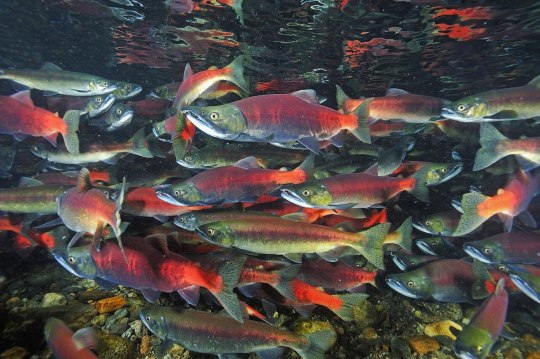
(kokanee salmon)
The Formosan landlocked salmon, also called the Cherry salmon, is found in Taiwan. Living in the Lishan mountain range, these fish survive in cold water at extremely high altitudes, with an upper temperature limit of 60 degrees. These fish are thought to have become landlocked by the warming of the Dajia River during the last ice age. They live along the many small creeks and backwater streams, with an extremely endangered population with only around 4,000 living at any given time. Cherry salmon are exceptionally small, reaching only 30cm (around a foot) with most around only 6 inches in their adult life. Subsisting off of bugs and small terrestrial life that gets close to the water. These fish survive only around 4 to 5 years before breeding in higher colder waters, and passing away for their fry to replace them.
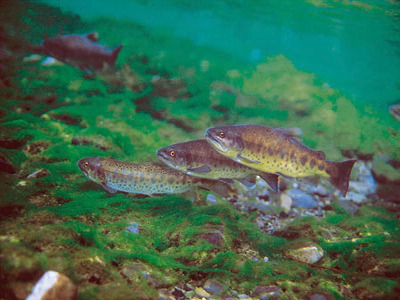
(Formosan landlocked salmon)
Those are the landlocked Salmon everybody! Have a wonderful day
#fish#fish of the day#fishblr#fishposting#aquatic biology#marine biology#freshwater#freshwater fish#animal facts#animal#animals#fishes#informative#education#aquatic#aquatic life#nature#river#ocean#salmon#landlocked#Formosan landlocked salmon#kokanee salmon#Atlantic salmon#sockeye salmon
85 notes
·
View notes
Text
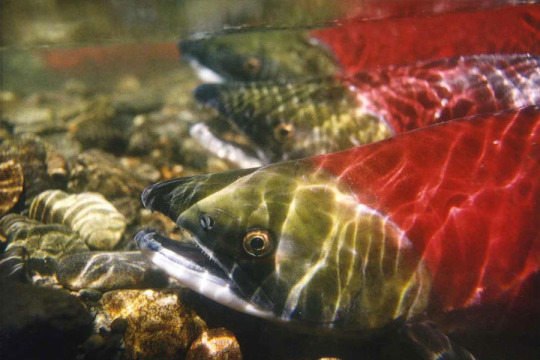


Settle In with the Sockeye Salmon
The sockeye salmon (Oncorhynchus nerka), also known as the red salmon, or the blueback salmon, is one of thirteen species of salmon endemic to the north Pacific Ocean. In their juvenile years they live in the open sea, but as fresh hatchlings and adults they can be found in freshwater rivers and streams. However, the subspecies known as the kokanee salmon are trapped in landlocked lakes and do not migrate as other sockeye salmon do. When migrating, the species can venture well inland to western North America and portions of eastern Asia, including Japan, Russia, and parts of Siberia.
Like most salmon, the sockeye is most famous for its lifecycle. It is an anadromous species, meaning that individuals migrate based on their life state. Newly hatched fry emerge from nests laid in the beds of freshwater systems, and spend their first 1-3 years before moving downstream to the ocean. There, they spend another 4-5 years in schools of up to several hundred, before they reach sexual maturity.
Beginning in July, mature adults begin the great migration back to the area in which they spawned. Once they reach their breeding grounds, males form into strict heirarchical groups and begin to court the available females. Meanwhile, each female digs a shallow nest in the riverbed and lays her eggs. Her chosen male partner-- or several-- lays a cloud of sperm over the eggs. A male may fertilize several nests before he dies; the female perishes soon after. The eggs, laid in clutches of up to 200, take approximately 40 days to hatch, at which point the cycle begins again.
As juveniles living in the ocean, red salmon are somewhat unremarkable. They have long, torpedo-shaped bodies that are generally silvery blue in color, sometimes with dark speckling. Individuals retain this coloring until well into their journy as adults, where males and females begin to significantly diverge. At their peak, adults may be anywhere from 60 to 84 cm (2 ft 0 in – 2 ft 9 in) in length and weigh from 2.3 to 7 kg (5–15 lb), with males being somewhat larger than females. Both males and females also change color; the head turns green, while the body turns bright red, although the color change is more striking in males. Finally, the shape of the male changes drastically, with the mouth becoming more hooked and the body growing a large hump.
Unlike other salmon, both adults and juvenile O. nerka feed throughout their lives. Fry and ocean-bound juveniles feed mainly on copepods and other zooplankton, while migrating adults also consume larger insects and invertebrates. Young blueback salmon are vulnerable to predation from larger fish such as lake trout, squawfish, and mountain whitefish, as well as larger invertebrates and frogs. Individuals living in the ocean are less predated upon, although they can still be caught by larger animals such as seals, sea lions, and sharks. Terminal-stage adults are large, easy targets and are consumed by a range of species; most namely bears and large birds such as gulls and eagles.
Conservation status: The IUCN considers the sockeye salmon to be of Least Concern. However, the species is listed on the United States Endangered Species Act. Populations have declined significantly throughout its range, largly due to overfishing, habitat degredation and the destruction of their breeding grounds.
Photos
NOAA Fisheries
Sergei Gorshkov
Roger Phillips
#sockeye salmon#Salmoniformes#Salmonidae#pacific salmon#salmon#salmonids#fish#freshwater fauna#freshwater fish#rivers#river fish#marine fauna#marine fish#open ocean#open ocean fish#Pacific ocean#north america#western north america#asia#east asia#north asia#animal facts#biology#zoology#ecology
72 notes
·
View notes
Text
🐠 - Fishuary!!

day 2 - salmonid
sockeye salmon / oncorhynchus nerka
@fish-daily
(( if you see day 3, no you don’t 💀💀
#fishuary2024#fishuary#drawing challenge#fishblr#salmon#sockeye#sockeye salmon#red salmon#fish art#fish drawing#colored pencil art#small artist#colored pencil#artists of tumblr#drawing challenge 2024#traditional art#traditional drawing#traditional artist
64 notes
·
View notes
Text
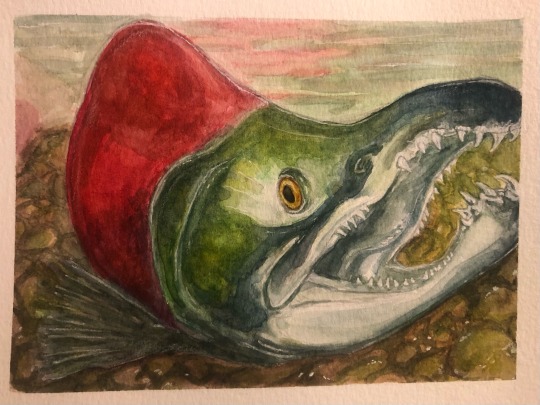
sockeye salmon
24 notes
·
View notes